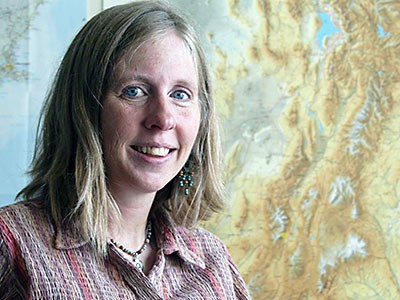USU Geologists: Nation's Capitol Sinking, Safety Measures Needed Now
USU alum Ben DeJong, who earned a master's degree in geology from Utah State in 2007, is lead author on a paper in 'GSA Today’ indicating Washington, D.C. is sinking.
Within the next century, Washington, D.C., could drop by half a foot, making it increasing vulnerable to rising sea levels say Utah State University geologists. Additionally, storm surge from hurricanes paralleling the magnitude of 2003’s Hurricane Isabel could inundate the nation’s coastal capitol and threaten venerated historical sites.
New research led by USU geology alum Ben DeJong ’07 MS confirms land under the Chesapeake Bay is sinking rapidly and Washington, D.C., will likely subside by six or more inches by the year 2100. DeJong, project geologist with the environmental consulting firm The Johnson Company, Inc. in Montpelier, Vt., says explanations for the subsidence reach back to the most recent Ice Age, but the sinkage is exacerbated by modern-day climate change.
“Right now is the time to start making preparations,” he says. “Six extra inches of water really matters in this part of the world.”
DeJong and Tammy Rittenour, associate professor in USU’s Department of Geology, along with DeJong’s doctoral advisor Paul Bierman of the University of Vermont, Wayne Newell and Shannon Mahan of the U.S. Geological Survey and Dylan Rood of Imperial College London, published findings in the July 27, 2015, online edition of GSA Today, a publication of the Geological Society of America.
DeJong says the capitol is sinking due to “forebulge collapse,” a geological phenomenon initiated by glacial advance and build-up of a North American ice sheet some 20,000 years ago.
The mile-high Laurentide Ice Sheet, which stretched from Canada to Long Island, N.Y., piled so much weight on the Earth that underlying mantle rock flowed slowly outward, he says. In response, the land surface to the south, under the Chesapeake Bay region, bulged up. Then, about 20,000 years ago, the ice sheet began melting away, allowing the forebulge to sink again.
“It’s a bit like sitting on one side of a water bed filled with very thick honey,” says DeJong, who earned a doctorate from the University of Vermont. “Then the other side goes up. But, when you stand, the bulge comes down again.”
Rittenour, director of the USU Luminescence Lab, says subsidence of the bay and D.C. area is accelerating the effects of local sea-level rise in the region due to the combined effects of sea-level rise due to warming and melting of global ice sheets.
“This is leading to faster and more severe sea-level rise and loss of land in this area than anywhere else along the East Coast,” she says.
To conduct the study, the researchers drilled 70 boreholes, many up to 100 feet deep, in around the Blackwater National Wildlife Refuge on the Chesapeake’s eastern shore. DeJong examined layers of sediment in these cores, using a suite of techniques and assistance from the USU Luminescence Lab to calculate the age of the sand, other rocks and organic matter in each layer. Combining this data with high-resolution LiDAR and GPS map data allowed the team to create a detailed 3D portrait of both current and previous post-glacial geological periods in the Chesapeake Bay region, stretching back several million years.
“This longer view gives us confidence that we have a bullet-proof model,” DeJong says. “It shows that the region today is in the early stage of a period of land subsidence that will last for millennia.”
Related links:
Contact: Tammy Rittenour, 435-213-5756, tammy.rittenour@usu.edu
Writer: Mary-Ann Muffoletto, 435-797-3517, maryann.muffoletto@usu.edu
Tammy Rittenour, associate professor in USU's Department of Geology and director of the USU Luminescence Lab, contributed to the study. Preparations are needed now, she says, to protect the nation’s capitol from rising sea levels.
TOPICS
Geosciences 74storiesComments and questions regarding this article may be directed to the contact person listed on this page.








